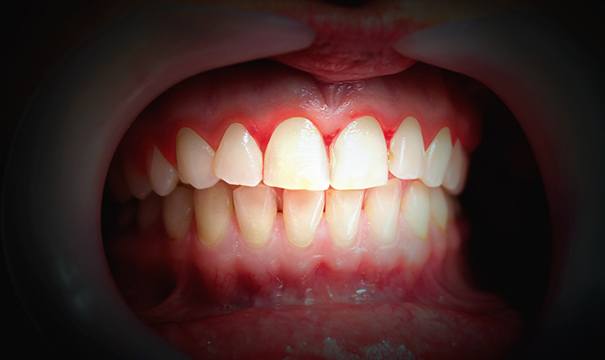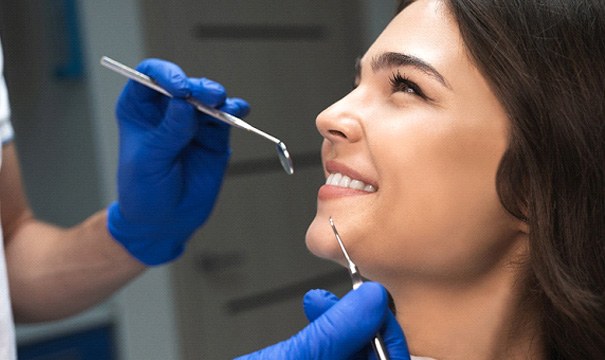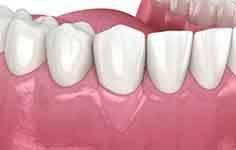Gum Disease Therapy – Boston, MA
Keep Your Gums Healthy
Many people underestimate just how much of a threat gum disease can be to oral health. The initial symptoms might not seem like anything to worry about, but ignoring the problem for too long can ultimately lead to missing teeth and other serious issues. Our in-house periodontist can help you restore the health of your smile with personalized gum disease therapy. Get in touch with us if you ever have reason to think that there might be a problem with your gums.
Why Choose Turning Leaf Dental for Gum Disease Therapy?
- In-House Periodontal Specialist
- Early Morning and Saturday Appointments
- Easily Accessible Office Location
What is Gum Disease?

Gum disease is sometimes referred to as periodontal disease. Simply put, it is an infection of the soft tissues around your teeth. The earliest stage of gum disease is gingivitis, which usually causes very mild symptoms; many people who are suffering from the condition right now don’t even know they have it. Over time, gingivitis can turn into periodontitis, which is a much more serious condition. Periodontitis can cause your gums and bone tissue to deteriorate, putting you at risk for tooth loss.
In addition to having a devastating effect on your oral health, gum disease may also contribute to problems throughout the rest of your body. Research has found that people with gum disease are more likely to experience heart problems, Alzheimer’s, and diabetes.
Symptoms of Gum Disease

The initial signs of gum disease can be hard to notice, which is why you might not even realize that you have it until your dentist identifies it. There are, nevertheless, several symptoms that are commonly linked to gum disease, including:
- Gum tissue that tends to bleed easily when you brush or floss.
- Gum tissue that has become noticeably red or swollen.
- Gum tissue that is unusually tender.
- Persistent bad breath.
- Teeth that appear longer than before (which is typically a result of gum recession).
- Teeth that have come loose.
Even if you haven’t noticed any signs of gum disease, you should still come into our office every six months for a checkup. We can catch the condition while it’s still in its early stages, which can make it much easier to treat before it can cause any permanent harm to your mouth.
How We Treat Gum Disease

Gum disease that is still in the gingivitis stage is often reversible. In some cases, treating the problem may be as simple as making a few adjustments to your oral hygiene routine and using a special kind of toothpaste. For more advanced cases of gum disease, specialized treatment may be required.
Sometimes we may recommend a deep cleaning procedure. The first step is to remove the bacteria that has accumulated above and below the gumline; this is known as scaling. For the next step, root planing, we will gently smooth out the roots of your teeth. Since bacteria have a harder time clinging to smooth tooth roots, this simple step can lower the risk of reinfection in the future.
Scaling & Root Planing

Scaling and root planing is a dental cleaning tailored to the health of your gums and roots. An ultrasonic cleaner will be used to get rid of any accumulated plaque and tartar along the gum line (scaling). Then, the rough surfaces of the tooth roots will be gently smoothed (root planing). The process is designed to minimize plaque and bacteria accumulation in the future and reduce the risk of reinfection.
Do I Need Scaling & Root Planing?

In the early stages, it might be possible to reverse gum disease through conservative measures. Simple adjustments to your brushing and flossing routines could be enough to restore your oral health. However, if the condition gets worse, our team may recommend scaling and root planing.
Here are signs that it's time to consult your dentist:
- Bleeding gums during brushing
- Redness and swelling of the gums
- Persistent bad breath
- Visible plaque accumulation along the gum line
- Gum recession
The Process of Scaling & Root Planing

Scaling and root planing typically requires multiple appointments and consists of two phases. First, we’ll use an ultrasonic scaler to carefully remove plaque and tartar from the teeth, addressing areas both above and below the gumline. We thoroughly clean the teeth within the extent of the gum pockets.
Following the scaling phase, we’ll move on to root planing. Here, we meticulously smooth the tooth roots to make it hard for bacteria to accumulate and reduce the likelihood of future infections. To ensure your comfort throughout the procedure, we administer local anesthesia. While you may feel some pressure as our team works, rest assured that you will not experience pain.
Aftercare Tips for Scaling & Root Planing

It may take several weeks for your gums to fully recover after scaling and root planing. To alleviate sensitivity and discomfort during the recovery period, consider the following tips:
- Frequently rinse your mouth with warm salt water
- Brush and floss your teeth gently
- Avoid spicy, acidic, hot, and cold foods
- Opt for a soft diet for at least 48 hours after your appointment
Gum Grafting

Other than the condition of your teeth, your gums are also an essential part of both your oral health and the appearance of your smile. In some cases, people might notice that their gum line can begin to recede, meaning more of your tooth (and its roots) can become exposed. This can be due to a variety of things, such as decay, aggressive brushing, or periodontal disease. To avoid further recession or even the possibility of tooth loss, our team can effectively restore the health and appearance of your gumline by performing a gum graft.
What is Gum Grafting?

Gum grafting is a surgical procedure that is meant to treat tooth roots that have been exposed due to excessive recession in the gum line. To do so, our team will take some gum tissue from the palate to cover up the roots while restoring the gum line. This periodontal treatment can generally be finished in just a single appointment. Our team will administer a local anesthetic so that you can remain pain-free throughout your procedure. Additionally, we can boost your healing capabilities by using platelet-rich plasma to speed up your recovery process.
In general, gum grafts are often reserved for patients who are interested in:
- Repairing gum recession
- Improving dental cosmetics
- Preparing for dental implant treatment
Benefits of Gum Grafting

Not only can exposed tooth roots make you more susceptible to sensitivity when eating or drinking anything particularly hot or cold, but they can also increase the risk of dental decay. With a gum graft, we can effectively reduce your chances of developing these complications or even prevent them altogether. Additionally, you’ll have better odds of avoiding tooth loss that can be caused by gum disease as well as improve the feeling and appearance of your overall smile. The best news: many of these benefits can be experienced virtually right after you’ve undergone the treatment.
Recovering After Gum Grafting Surgery

Before and after your procedure, our team will provide you with specific aftercare instructions so that you can take proper care of your smile while you heal from the surgery. Your recovery process will depend mostly on the amount of pressure applied to the area following your treatment. Since your gums will be sensitive, you’ll need to be careful while eating and drinking. It can typically take around four to eight weeks for your surgical site to heal completely, which can vary based on the amount of tissue used for your graft. As mentioned before, our team can utilize platelet-rich plasma to help make your healing period faster and more efficient as well as reduce swelling and discomfort. If you notice any issues during recovery, notify our team for help.

